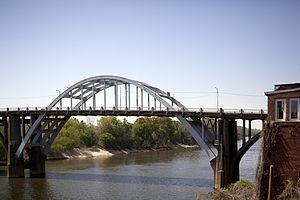Edmund Pettus Bridge | |
|---|---|
 The central span of the Edmund Pettus Bridge in April 2010 | |
| Coordinates | 32°24′20″N 87°01′07″W / 32.40556°N 87.01861°W |
Edmund Pettus Bridge | |
| Location | Selma, Alabama, U.S. |
| Built | 1940 |
| Built by | T. A. Loving Company |
| NRHP reference No. | 13000281 |
| Significant dates | |
| Added to NRHP | February 27, 2013[1] |
| Designated NHL | February 27, 2013 |
| Carries | |
| Crosses | Alabama River |
| Characteristics | |
| Design | Through arch bridge |
| Total length | 1,248.1 feet (380.4 m) |
| Width | 42.3 feet (12.9 m) |
| Longest span | 250 feet (76 m) |
| No. of spans | 8 |
| Piers in water | 4 |
| Clearance above | 14.8 feet (4.5 m) |
| History | |
| Construction start | 1939 |
| Construction end | 1940 |
| Opened | May 25, 1940 |
| Statistics | |
| Daily traffic | 17,720 |
| Location | |
 | |
The Edmund Pettus Bridge carries U.S. Route 80 Business (US 80 Bus.) across the Alabama River in Selma, Alabama. Built in 1940, it is named after Edmund Pettus, a former Confederate brigadier general, U.S. senator, and state-level leader ("Grand Dragon") of the Alabama Ku Klux Klan.[2] The bridge is a steel through arch bridge with a central span of 250 feet (76 m). Nine large concrete arches support the bridge and roadway on the east side.
The Edmund Pettus Bridge was the site of the conflict of Bloody Sunday on March 7, 1965, when police attacked Civil Rights Movement demonstrators with horses, billy clubs, and tear gas[3] as they were attempting to march to the state capital, Montgomery.[2] The marchers crossed the bridge again on March 21 and walked to the Capitol building.
The bridge was declared a National Historic Landmark on February 27, 2013.[1][4]
- ^ a b "Edmund Pettus Bridge". National Register of Historic Places. National Park Service.
- ^ a b Whack, Errin (March 7, 2015). "Who Was Edmund Pettus?: The march to freedom started on a bridge that honors a man bent on preserving slavery and segregation". Smithsonian Magazine. Smithsonian Institution. Retrieved June 19, 2022.
- ^ "We Shall Overcome – Selma-to-Montgomery March". National Park Service. April 23, 2020. Retrieved October 11, 2017.
- ^ "America's Great Outdoors: Secretary Salazar, Director Jarvis Designate 13 New National Historic Landmarks" (Press release). US Department of the Interior. March 11, 2013. Retrieved July 26, 2020.